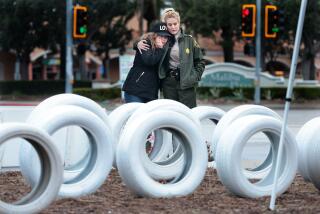In Suburbs, Freeway Drivers Hit the Gas--and Get Tickets
- Share via
Armed with bigger cars and increasingly frustrated with urban congestion, California drivers are breaking speed limits more often than ever on some freeways, according to experts and new state data.
An analysis of state records shows a growing number of drivers are increasing their speeds where traffic lightens in many suburban areas of Southern California.
Average speeds on the Santa Ana Freeway in Irvine, for example, jumped from 64 mph to 69 mph between 1997 and 1999, and on Interstate 5 near Encinitas in San Diego County from 68 to 71 mph.
A different measure shows that the trend is being seen across California, particularly in remote areas. The number of motorists ticketed for going more than 100 mph doubled statewide during the 1990s, from 4,895 to 9,716.
“It’s crazy out here, man,” said Bradley Eldon Cahill, a San Diego businessman recently cited for going 92 mph along Interstate 5 in San Clemente. “People were passing me at 100 mph.”
Despite the rising speeds, the number of fatalities on the freeways has remained flat or actually declined, mirroring a national trend that experts attribute to better engineered cars and increased use of seat belts.
Still, CHP officers and traffic safety experts worry that if the trend continues, the roads will become more dangerous.
“You can’t get away from physics,” said Richard Retting, a senior transportation engineer with the nonprofit Insurance Institute for Highway Safety. “The bottom line is, there’s a price we pay for going faster.”
Transportation experts said they expected drivers would hit their accelerators harder when many California freeways increased speed limits from 55 mph to 65 mph in 1996. But they expressed surprise and concern that some speeds are continuing to rise four years after the change.
One reason, experts say, is the growing popularity of cars with big engines, including pickup trucks and sport utility vehicles. Not only are the powerful engines quieter than four-cylinder models, but many new cars better insulate drivers from engine noise.
“Sometimes you get in a daze,” said one 27-year-old woman who was pulled over on the San Diego Freeway near San Clemente. Ticketed for going 88 mph in the slow lane, she said her 1999 Saturn “sealed” her from the speed. “I had no idea how I was going so fast,” she said.
The booming economy appears to also be playing a role, as more people can now afford bigger cars and trucks. Some note that motorists are also more impatient with congested freeways, and compensate by driving extra fast when traffic improves in suburban areas.
“Drivers get very frustrated in traffic after all the money they spend on their expensive vehicles,” said Paul Snodgrass, a highway safety specialist with the National Highway Traffic Safety Administration. “As soon as traffic lightens, off they go.”
A report issued last year by the Washington-based Surface Transportation Policy Project reached a similar conclusion, finding the highest rates of death caused by speeding and other aggressive driving behavior in areas of suburban sprawl. The highest rate among 37 metropolitan areas nationally was in the Riverside-San Bernardino region.
The CHP data measured car speeds monitored by sensors embedded in freeways across the state. Because the sensors measure the speeds of all vehicles, and not just those caught in periodic radar monitoring, the data are considered among the most accurate measures of traffic activity.
Freeways in remote areas tended to record the highest average speeds. On Interstate 5 in Shasta County, the average speed in 1999 was 70 mph. On Interstate 15 in the Mojave Desert, the average speed was 75 mph.
“People really fly through here,” said Randy Dopp, a CHP officer who patrols the wide-open desert areas of Riverside County. The 12-year veteran said he once ticketed eight drivers in one day for going more than 100 mph.
In an average year, Dopp issues about 150 tickets to motorists going more than 100 mph--most of them driving on Interstate 10 on the way to Palm Springs. He has pulled over famous athletes, Hollywood stars and doctors speeding to hospital emergencies.
“I could write 50 tickets in a day for people going over 80 mph, so I try to find the worst of the worst,” he said.
Like Dopp, officers statewide focus on snaring the most blatant offenders.
Orange County CHP Officer Steven Miles usually limits enforcement to motorists driving more than 20 mph over the 65-mph limit. On a recent afternoon while he patrolled the southbound San Diego Freeway the speeds were typical, with traffic moving about 75 mph.
Miles is part of an aggressive radar enforcement program begun by the CHP in 1998 to combat speeding. Radar is now used on a third of all California freeways, and officials attribute the technology to helping catch more speed violations. Miles said radar is helping to ticket more speeders but he believes the rise in citations is largely explained by the ever-growing number of people who disobey the limits.
Miles parked at the “fishing hole”--a downgrade through San Juan Capistrano where officers like to troll for speeders.
Soon, an angry 25-year-old Los Angeles woman was taunting Miles for pulling her over. “I wasn’t going 88,” she yelled defiantly before speeding off in her 1995 Toyota Corolla. “I was going 95.”
(BEGIN TEXT OF INFOBOX / INFOGRAPHIC)
Pedal to the Metal
Citations statewide for driving more than 100 mph:
*
1991: 4,895
1999: 9,716
*
Source: CHP
More to Read
Sign up for Essential California
The most important California stories and recommendations in your inbox every morning.
You may occasionally receive promotional content from the Los Angeles Times.











